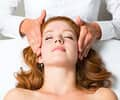Signs & Symptoms
There are many signs and symptoms of TMD. It's often hard to know for sure if you have TMD, because one or all of these symptoms can also be present for other problems. Your dentist can help make a proper diagnosis by taking a complete medical and dental history, conducting a clinical examination and taking appropriate X-rays.
Some of the most common TMD symptoms include:
- Pain in the face, jaw or ear area
- Headaches (often mimicking migraines), earaches, and pain and pressure behind the eyes
- A clicking or popping sound when opening or closing the mouth
- Jaw that "gets stuck," locked or goes out of place
- Tenderness of the jaw muscles
- Trouble chewing or biting
- Swelling of the face
- A sudden change in the person’s dental occlusion (the way the upper and lower teeth fit together)
Cause
- Often, TMD arises from problems with the muscles in the jaw or the joint itself. Your jaw may be popping or clicking or even "getting stuck" every now and then. It is important to see a dentist or dental specialist for a consultation to determine the cause of the oral problem.
Diagnosis
To properly diagnose TMD, your dentist will conduct a thorough medical and dental evaluation and may take certain X-rays (panoramic) to evaluate the jaw joint and surrounding structures and check your occlusion. They may check the muscles and tissues of the head and neck to test for inflammation. Certain exercises and movements may be involved, and you may get a referral to an oral and maxillofacial surgeon for further evaluation and diagnosis.
Treatment
While there is no single cure for TMD, there are different treatments that may reduce your symptoms dramatically. Your dentist may recommend one or more of the following:
- Trying to eliminate muscle spasm and pain by applying moist heat or taking medication, such as muscle relaxants, aspirin, other over-the-counter pain-relievers or anti-inflammatory drugs.
- Reducing the harmful effects of clenching and grinding by wearing a night guard or splint. Custom-made to fit your mouth, the device slips over the upper teeth and keeps them from grinding against the lower teeth.
- Learning relaxation techniques to help control muscle tension in the jaw. Your dentist may suggest you seek training or counseling to help eliminate stress.
- Transcutaneous electrical nerve stimulator (TENS) uses low-level electrical currents to relax joint and facial muscles and provide relief. Low-level laser therapy will assist in helping the neck to move more freely.
- A dentist may prescribe non-steroidal anti-inflammatory drugs to relieve pain and swelling.
Related Conditions
TMJ includes a wide range of disorders that often overlap. They include:
- Muscle problems that affect jaw movement
- Pain in the face around the jaw joint
- Problems within the joint itself
This variety makes diagnosis and treatment challenging. An accurate diagnosis is critical for successful treatment.
This article is intended to promote understanding of and knowledge about general oral health topics. It is not intended to be a substitute for professional advice, diagnosis or treatment. Always seek the advice of your dentist or other qualified healthcare provider with any questions you may have regarding a medical condition or treatment.
ORAL HEALTH QUIZ
What's behind your smile?
Take our Oral Health assessment to get the most from your oral care routine
ORAL HEALTH QUIZ
What's behind your smile?
Take our Oral Health assessment to get the most from your oral care routine
Join Us
Get the best of your oral health routine and take it to the next level with expert advice, recommendations, products and solutions and special offers.
Join Us
Get the best of your oral health routine and take it to the next level with expert advice, recommendations, products and solutions and special offers.















